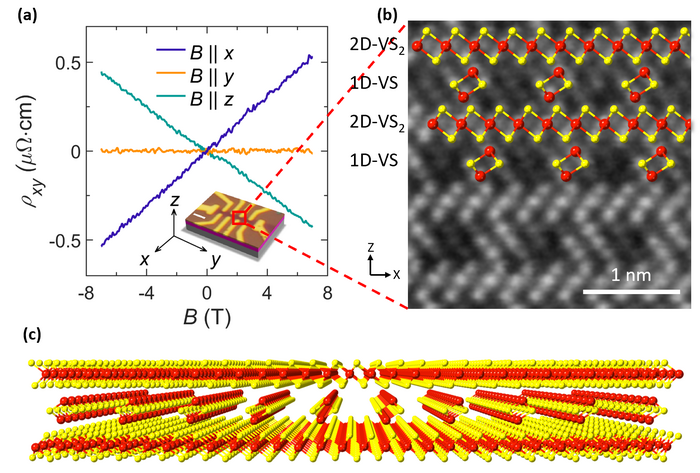An innovative metal superlattice is created using common nanofabrication methods by researchers from Osaka University and collaborating partners. This innovation will increase the usefulness of microelectronics in mainstream technologies.
 Discovery of a new superlattice structure exhibiting the anisotropic Hall effect. (a) Anisotropic Hall effect. (b) Scanning transmission electron microscopy (STEM) cross sectional image of 2D-VS2/1D-VS superlattice structure. (c) Schematic model of the 2D/1D hybrid superlattice. Image Credit: Y.C. Lin
Discovery of a new superlattice structure exhibiting the anisotropic Hall effect. (a) Anisotropic Hall effect. (b) Scanning transmission electron microscopy (STEM) cross sectional image of 2D-VS2/1D-VS superlattice structure. (c) Schematic model of the 2D/1D hybrid superlattice. Image Credit: Y.C. Lin
Understanding and controlling the motion of electrons in a metal is essential for advancements in contemporary microelectronics. Metal sheets can be made as thin as a few nanometers, which enables precise control over the motion of the metal’s electrons.
By doing this, it is possible to add features, such as rapid electrical conductivity, that are not present in bulk metals. Recently, scientists from Osaka University and their colleagues in research have created a brand-new class of nanostructured superlattices.
With the help of this research, it is now possible to control the movement of electrons within metal semiconductors to an extraordinarily high degree, which should improve the operation of modern technology.
It is still a current area of research to fine-tune the architecture of metal nanosheets to enable enhanced microelectronic functions. In reality, this subject has received many Nobel prizes.
By using materials with the same dimension, such as sandwiched 2D sheets, scientists can create nanostructured superlattices, which are made up of regularly alternating layers of metal.
The ease with which hetero-dimensional superlattices, such as chains of 1D nanoparticles sandwiched between 2D nanosheets, can be made is a crucial feature of the current researchers’ work.
Nanoscale hetero-dimensional superlattices are typically challenging to prepare, but can exhibit valuable physical properties, such as anisotropic electrical conductivity. We developed a versatile means of preparing such structures, and in so doing we will inspire synthesis of a wide range of custom superstructures.
Yung-Chang Lin, Study Senior Author, Osaka University
Vanadium-based superlattices were created by researchers using chemical vapor deposition, a popular nanofabrication technology in the industry. Anisotropic anomalous Hall effect (AHE), which is directionally concentrated charge buildup under in-plane magnetic field conditions (where the conventional Hall effect is not detected), is demonstrated by these magnetic semiconductors.
The AHE is typically only noticed at extremely low temperatures. The AHE was detected in the current study at temperatures above room temperature, up to at least the boiling point of water. It will be easier to apply the AHE in everyday technologies if it can be produced at realistic temperatures.
Lin stated, “A key promise of nanotechnology is its provision of functionalities that you can’t get from bulk materials. Our demonstration of an unconventional anomalous Hall effect at room temperature and above opens up a wealth of possibilities for future semiconductor technology, all accessible by conventional nanofabrication processes.”
The current work will contribute to increasing electronic device speed, lighting efficiency, and data storage density. Researchers will create incredibly adaptable technology that outperforms the utility of natural materials by accurately manipulating the nanoscale architecture of metals that are frequently utilized in industry.
Journal Reference:
Zhou, J., et al. (2022). Heterodimensional superlattice with room-temperature anomalous Hall effect. Nature. doi:10.1038/s41586-022-05031-2